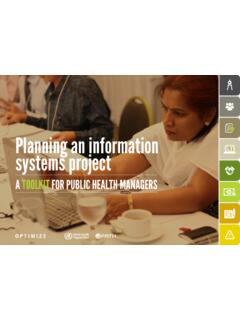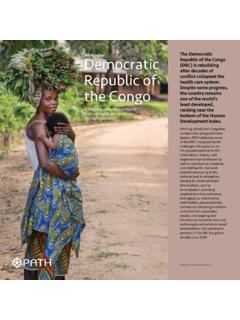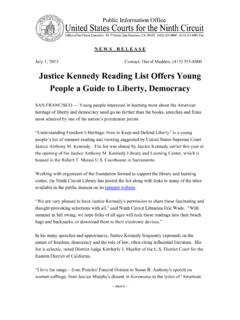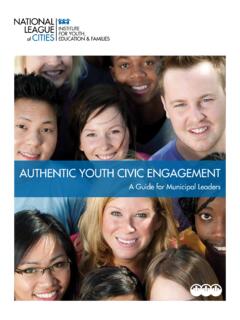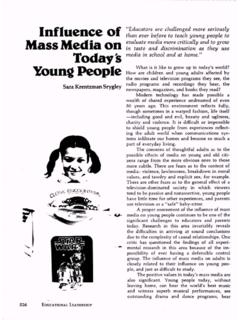Transcription of Tuko Pamoja: A Guide for Talking With Young People About ...
1 Tuko PamojaA Guide for Talking with Young Peopleabout their Reproductive HealthA Guide for Talking with Young Peopleabout their Reproductive HealthAcknowledgementsThis document is part of the Kenya Adolescent Reproductive Health Project s (KARHP) Tuko Pamoja (We areTogether) series. It is based on KARHP s Adolescent Reproductive Health and Life Skills Curriculumand drawsfrom other adolescent reproductive health and youth-friendly publications including EngenderHealth s Youth-Friendly Services: A Manual for Service Providers, FOCUS on Young Adults Making Reproductive Health ServicesYouth Friendly, PATH's Life Planning Skills: A Curriculum for Young People in Africa and PathfinderInternational s Reproductive Health Services for Adolescents: Comprehensive Reproductive Health and FamilyPlanning Training Curriculum.
2 Full references can be found in the reference section of this Guide was developed by Stephanie Martin with input from Oluoch Madiang , Eva Muthuuri, Rikka Trangsrudand Jon Kaplan. Cover illustration by Eric for the development and production of this Guide was provided to the Kenya Adolescent ReproductiveHealth Project (KARHP) through the President s Emergency Plan for AIDS Relief and the Office of Population ofthe United States Agency for International Development. The opinions expressed herein are those of theauthors and do not necessarily reflect the views of 2005, Program for Appropriate Technology in Health (PATH). All rights reserved. Any part of thismanual may be photocopied or adapted without permission, provided that the parts copied are distributed freeor at cost (not for profit) and that credit is given to KARHP, PATH and Population 2005 PATHACS Plaza, 4thFloor, Lenana Box 76634-00508 Nairobi, KenyaTel: 254-20-3877177 Population CouncilGeneral Accident Insurance HouseRalph Bunche Box 17643 Nairobi, KenyaTel: 254-20-2713480 ContentsIntroduction.
3 1 Adolescence ..2 What are Your Values? ..3 Being Youth Friendly ..4 Talking with Young People ..4 Talking About Sexuality with Young a Group Discussion ..8 Ten Tips for Facilitating a Discussion ..10 Talking About Uncomfortable ..12 Sexuality ..15 Unintended Pregnancy ..16 Unsafe Abortion ..16 Sexually Transmitted Infections ..17 HIV and Counselling and and Support for People with HIV and AIDS ..23 Abstinence ..25 Condoms ..26 Preventing Pregnancy ..27 Drug Use ..28 Sexual Violence ..29 Accommodating Youth with Special 1: Contraceptive Methods Overview ..32 Resource 2: How to use a Male Condom ..34 Resource 3: How to use a Female Condom ..35 References ..36 The FactsSexually Transmitted Infections (STIs)
4 Young People have much higher rates of STIs than adults for both biological and behavioural People s immature immune and reproductive systems make them vulnerable to People aged 15-24 account for half of all new HIV infections in with an STI increases the risk of becoming infected with pregnancyBy age 19, almost half of adolescents in Kenya have begun risk of maternal death among pregnant women ages 15-19 is four times higher than the risk amongwomen ages births are more likely to result in low birth weight, premature births, stillbirths, and thousand girls drop out of school every year in Kenya because of useFew married Young People use People often do not plan to have sex and do not have contraceptives with People lack information and knowledge About health risks faced by adolescentsYoung People take higher risks in general, including unprotected women are less able to resist sexual pressure and People in disadvantaged situations are vulnerable to sexual women are disproportionately represented among :Central Bureau of Statistics (CBS) [Kenya], Ministry of Health (MOH) [Kenya], and ORC Macro.
5 Kenya Demographic and Health Survey2003. Calverton, Maryland: CBS, MOH, and ORC Macro; 2004. MOH Division of Reproductive Health. National guidelines for provision of youthfriendly services in Kenya. Nairobi: 2005. EngenderHealth. Youth Friendly Services: A Manual for Service Providers. [Draft]New York: 2002. PATH,Population Council. Tuko Pamoja: Adolescent Reproductive Health and Life Skills Curriculum. Nairobi: PATH; is the time of transition between childhood and adulthood. During this time, Young People expe-rience many physical, emotional and social changes. Physical changes, such as menstruation in girls or devel-opment of facial hair in boys, can be confusing and worrisome for adolescents.
6 During adolescence, youngpeople develop new interests and attempt to establish their independence from adults. Peer pressure increas-es and can become particularly difficult for Young People to resist. Providing Young People with support bytalking with and listening to them as well as ensuring they have access to accurate information can help themunderstand the wide range of changes they are experiencing, and make this transition period , many adolescents do not have access to the reproductive health information they need to makeinformed choices About their health and their futures. They may be embarrassed asking parents or other adultsquestions About sexual and reproductive health.
7 Although parents, teachers, religious and community leaders,and health care providers are expected to educate adolescents About personal and physical development, rela-tionships and their roles in society, it may be difficult for them to do so in a comfortable and unbiased way. For these reasons, it is important to meet adolescents need for information and services. This can help themresist peer pressure to become sexually active and protect themselves against unintended pregnancies andsexually transmitted infections, including HIV, if they decide to have sex. Young People have both the needand the right to access this type of information and services.
8 Adolescent reproductive health education pro-vides adolescents with information About reproductive physiology and puberty; protective behaviour, includ-ing abstinence and contraceptives; and the responsibilities and consequences that come with sexual activity. Importance of working with youthThe social and developmental consequences of sexual and reproductive decisions are far-reaching. Health,education, interpersonal relationships and preparation for the world of work are closely linked. An unintend-ed pregnancy can permanently change a Young girl s life. It can be difficult for her to return to school and con-tinue with the plans she had for her future. Becoming HIV positive can bring an end to a Young person sprospects for a healthy and productive future.
9 Young People have a right to the information and services they need to make healthy decisions About theirlives. Providing Young People with accurate reproductive health information promotes sexual health and well-being. This includes supporting healthy, responsible and positive life experiences, as well as preventing dis-ease and unintended pregnancy. Sexuality education is most meaningful and effective when it provides infor-mation, challenges myths, explores values, and develops believe that education on sexuality, reproduction, HIV and AIDS and safer sex will encourage adolescentsto engage in sexual activity. In fact, this type of information generally leads to more responsible and safer atti-tudes towards sex and sexual relationships.
10 Studies have shown no evidence that sexuality education leads toan increase in sexual activity; rather in many cases it leads to a delay in sexual initiation. Sexuality educationprovides knowledge About reproductive functions and processes, puberty and pregnancy and STI prevention. Itemphasizes a broad approach to sexuality, focusing on a whole person and presenting sexuality as natural anda positive part of life. Telling the truth About sexuality could make it easier for Young People to talk with par-ents, teachers, community and religious leaders and other influential adults. AudienceThis Guide was developed for Public Health Technicians working with the Ministry of Health as part of the KenyaAdolescent Reproductive Health Project.


